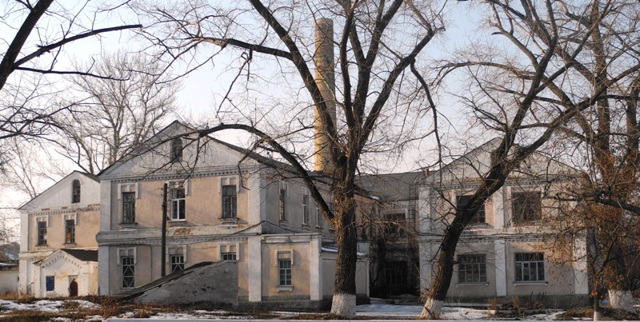Functional temporarily unavailable
Klynova-Novoselivka
Travel guide online Klynova-Novoselivka
General information about Klynova-Novoselivka
The large village of Klynova-Novoselivka on the Hayvoronka River is located 15 kilometers northwest of Zolochiv, 50 kilometers from Kharkiv, near the Russian border.
It was founded in the 18th century as Klynove-Novoselivka. In the middle of the 19th century, Klynova-Novoselivka belonged to Count Petro Kleynmikhel, in honor of his wife, the village was then called Kleopatrivka. Later, it was renamed Oleksandrivka on the occasion of the accession of Oleksandr III to the Russian throne. In Soviet times, it was called Konhresivka in honor of the Comintern Congress. After Ukraine gained independence, it was again called Oleksandrivka. In 202 ...
The large village of Klynova-Novoselivka on the Hayvoronka River is located 15 kilometers northwest of Zolochiv, 50 kilometers from Kharkiv, near the Russian border.
It was founded in the 18th century as Klynove-Novoselivka. In the middle of the 19th century, Klynova-Novoselivka belonged to Count Petro Kleynmikhel, in honor of his wife, the village was then called Kleopatrivka. Later, it was renamed Oleksandrivka on the occasion of the accession of Oleksandr III to the Russian throne. In Soviet times, it was called Konhresivka in honor of the Comintern Congress. After Ukraine gained independence, it was again called Oleksandrivka. In 2024, in accordance with the requirements of the law of Ukraine "On condemnation and prohibition of propaganda of Russian imperial policy in Ukraine and decolonization of toponymy", the village of Oleksandrivka returned its historical name - Klynova-Novoselivka.
In 1905, Count Mykola Kleynmikhel, the county leader of the nobility, began the construction of a large sugar factory in the village, which was called Konhresivsky factory since Soviet times. The factory manager's office building (1914), dormitory and library building (1916) have been preserved. The historic part of the village is surrounded by a slag wall - there are the factory manager's house, a water pump, and an old park.
The Ukrainian-Russian border crossing, which had the status of a local one, was located near the village.
Велике село Клинова-Новоселівка на річці Гайворонка розташоване в 15 кілометрах на північний захід від Золочева, в 50 кілометрах від Харкова, поблизу російського кордону.
Засноване в XVIII столітті як Клинове-Новоселівка. В середині XIX століття Клинова-Новоселівка належала графу Петру Клейнміхелю, на честь його дружини тоді село назвали Клеопатрівкою. Згодом було перейменоване на Олександрівку з нагоди вступу Олександра ІІІ на російський престол. В радянські часи називалося Конгресівка на честь конгресу Комінтерну. Після здобуття Україною Незалежності знову називалося Олександрівка. В 2024 році відповідно до вимог закону України "П ...
Велике село Клинова-Новоселівка на річці Гайворонка розташоване в 15 кілометрах на північний захід від Золочева, в 50 кілометрах від Харкова, поблизу російського кордону.
Засноване в XVIII столітті як Клинове-Новоселівка. В середині XIX століття Клинова-Новоселівка належала графу Петру Клейнміхелю, на честь його дружини тоді село назвали Клеопатрівкою. Згодом було перейменоване на Олександрівку з нагоди вступу Олександра ІІІ на російський престол. В радянські часи називалося Конгресівка на честь конгресу Комінтерну. Після здобуття Україною Незалежності знову називалося Олександрівка. В 2024 році відповідно до вимог закону України "Про засудження та заборону пропаганди російської імперської політики в Україні і деколонізацію топонімії" селу Олександрівка повернули історичну назву - Клинова-Новоселівка.
В 1905 році граф Микола Клейнміхель, повітовий предводитель дворянства, почав в селі будівництво великого цукрового заводу, який з радянських часів називався Конгресівським. Збереглася будівля контори керуючого заводом (1914 рік), будівлі гуртожитку та бібліотеки (1916 рік). Історична частина села обнесена стіною зі шлаку - там знаходяться будинок керуючого заводом, водокачка, старий парк.
Поруч з селом розташовувався українсько-російський прикордонний перехід, що мав статус місцевого.
Сплануй своє перебування у Klynova-Novoselivka
What to see and where to go in Klynova-Novoselivka
Tourist attractions and museums of Klynova-Novoselivka

Konhresivsky Sugar Plant
Architecture
The Konhresivsky Sugar Plant in Klynova-Novoselivka was built in 1905 by Count Mykola Kleynmikhel, the leader of the nobility of Bohoduhiv County.
The premises of the sugar factory manager's office (1914) have been preserved. In the 1990s, the interiors were destroyed, in particular, the twisted cast-iron staircase leading to the second floor to the manager's office. The building of the dormitory and library of the sugar factory (1916) has also been preserved.
On the opposite bank of the Sugar Pond, in the historical part of Klynova-Novoselivka village, you can see the former house of the factory manager (1 Tsentralna Street), a water pump, and an old park.
Reviews Klynova-Novoselivka
Geographical information about Klynova-Novoselivka
| {{itemKey}} | {{itemValue}} |
|---|---|
| Region |
Kharkiv |


